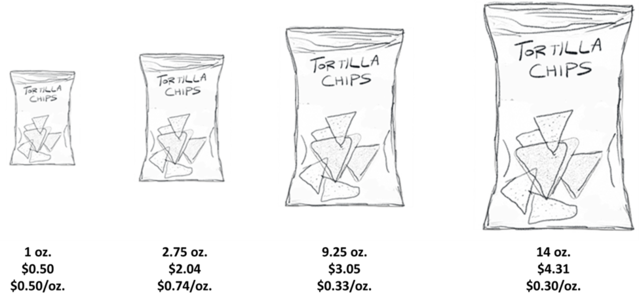Consumer Behavior
What Consumers Get Wrong About Shrinkflation
The reasons for shrinkflation and its effects on consumers are misunderstood.
Posted April 4, 2022 Reviewed by Michelle Quirk
Key points
- Most well-known packaged food brands don't sell one item; they sell an entire line.
- Quantity or weight fluctuations are frequent occurrences, not one-time events.
- It's improbable that a brand will reduce the quantity or weight of all the items in its line.
As inflation has continued to rise over the past year and consumers are paying more attention to their grocery store spending, shrinkflation is in the news virtually every day.
What Exactly Is Shrinkflation?
Shrinkflation is a tricky concept that appears simple on the surface. Some people equate shrinkflation with cost-cutting by companies, which provides an incomplete picture. A better definition is that a particular company has reduced the quantity or weight of one specific item it sells without changing the price. The effect is a one-time indirect price increase for consumers.
For example, Newsweek recently reported that a bag of Doritos that used to weigh 9.75 ounces now weighs 9.25 ounces, resulting in five fewer chips on average in the bag. Doritos' buyers pay approximately 5 percent more per ounce because of the change. Many one-time quantity reductions are accompanied by packaging changes. The seller may subtly change the package's shape, introduce a new description, use different images and colors, etc. It's not surprising, then, that discussions about shrinkflation see it as a way for manufacturers and retailers to trick consumers into paying higher prices.
What Consumers Should Understand About Shrinkflation
While there may be some truth to the idea that shrinkflation is sneaky, the reality is more complicated and nuanced. Even though most articles about shrinkflation discuss quantity or weight reductions for a single item like the Doritos 9.75-oz package, managers rarely think about shrinking single packages once. Instead, they think about varying prices and volumes or weights of their entire product line on an ongoing basis. And even when a brand practices shrinkflation for one package, it does not necessarily mean that all consumers will pay a higher price. Many may end up paying a lower price. In this post, I want to unpack these ideas to provide a more detailed understanding of the marketing strategy behind shrinkflation and its effects on consumers.
1. Most well-known packaged food brands don't sell one item; they sell an entire line. Doritos chips are available in different flavors and sizes, covering an entire shelf. For example, in the supermarket I go to, the Doritos Cool Ranch flavor alone is currently available in four package sizes: 1 oz., 2.74 oz., 9.25 oz, and 14 oz. In other stores like Costco or Walmart, they may be available in still other sizes and multipacks. The brand, like others, makes dozens of sizes and configurations, a marketing practice called "price pack architecture."
With price pack architecture, the brand frequently changes which packages they offer customers by adding and subtracting items from their product line. This may also involve changing flavors, colors, fragrances, package design, etc. The "architecture" refers to the fact that there is a structure to how managers define and choose the different sizes, features, and prices, typically by conducting consumer research and examining the level of sales, consumer preferences, profitability, and so on. Inflation is just one factor in this decision-making and likely not the most crucial consideration.
2. Quantity or weight fluctuations are frequent occurrences, not one-time events. The architecture of any brand's product line is constantly changing. It is an ongoing process with different items being modified in small ways. For instance, the 1.25-oz package may be replaced by a 1-oz package, then go up in weight to 1.1 oz, and both or all three sizes may be available at the same time, but the brand may choose to push its 1.1-oz package because it is the most profitable one. Or the brand may rotate these different-sized packages in and out of different stores. As the example illustrates, not all package size changes are shrinkages. Brands may also increase their package sizes for various reasons. For example, one British study conducted by the UK's Office for National Statistics in 2019 "estimated that between 1% and 2.1% of food products in [the] sample shrank in size, while between 0.3% and 0.7% got bigger."
3. It's improbable that a brand will reduce the quantity or weight of all the items in its line. For managing price pack architecture, it's not a simple matter of having just one package available and then downsizing it or reducing the quantity or weight of all items in the line simultaneously. It is a matter of managing the brand's portfolio, varying the packages that it makes available through stores at any given time. The manager's goal is to make the most sales and profit for their entire product lineup, not one particular package.
4. Even with shrinkflation, consumers can still purchase the product at a reasonable price. Another complicating factor is that package prices and sizes do not correlate consistently.

In the figure, the 1-oz tortilla chips package costs 50 cents, but the 2.75-oz package costs $2.04, which translates to 74 cents per ounce. Customers are paying more per ounce for the larger package. However, the price per ounce is substantially lower for the two largest package sizes. The 9.25-oz package costs $3.05, or 33 cents per ounce, and the 14-oz package costs $4.31, or 30 cents per ounce.
Imagine that the brand decides to shrink the 9.25-oz package, making it 8.75 oz while keeping the price unchanged at $3.05. The price will increase to 35 cents per ounce. Only those customers who purchased the 9.25-oz package before and continue to buy the 8.75-oz package now will be affected by the shrinkflation. Consumers purchasing any other package will see no change in price. Even those who purchased the 9.25-oz package before could shift to buying the 14-oz package, in which case they will pay a lower price per ounce than they did before the shrinkflation of the 9.25-oz package.
Conclusion
This example provides two valuable lessons for consumers. First, when making buying decisions for packaged food items like tortilla chips in the grocery store, the smart way to shop is to compare the prices of the different packages using a "unit pricing" comparison such as the price per ounce. Marketers often use tricky and nonintuitive pricing strategies like charging a higher unit price for a larger package (see the 1-oz vs. 2.75-oz prices in the example). Making purchase decisions using unit pricing is the only way consumers can bypass such tricks. Second, when a brand performs shrinkflation, it does not have to hurt consumers' wallets. If they pay attention and change the package they buy, chances are they will be able to pay the same or an even lower price (on a per-unit basis) for their purchase.




